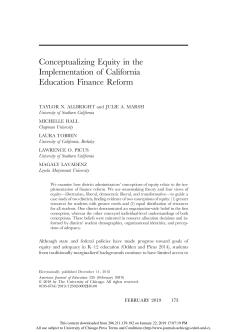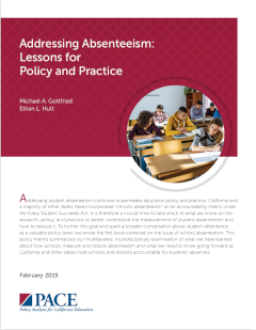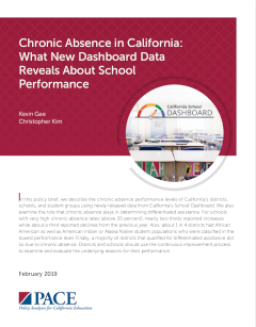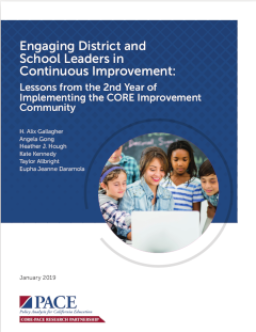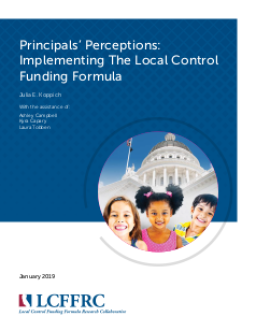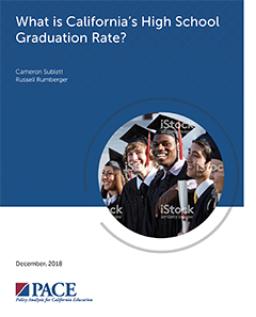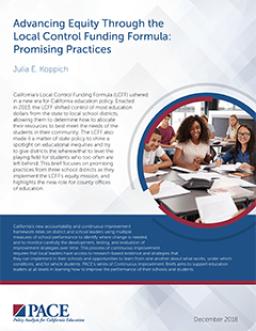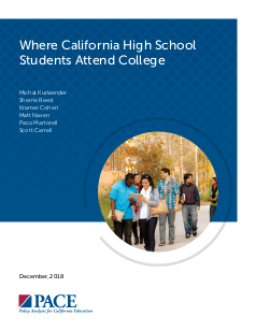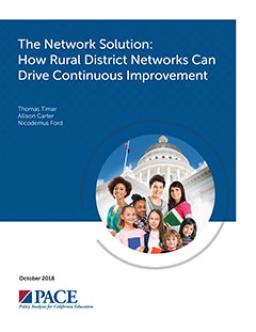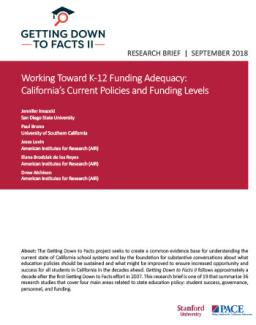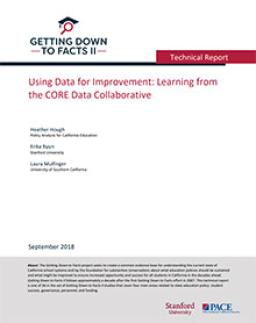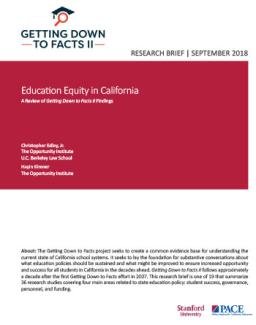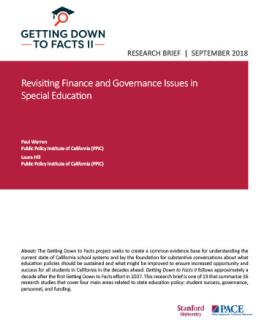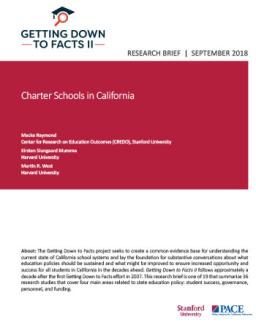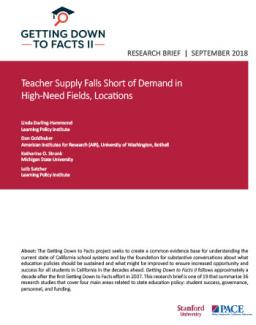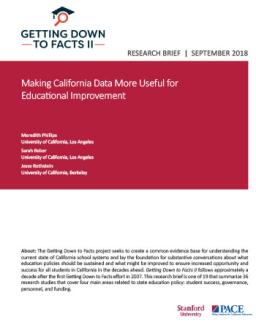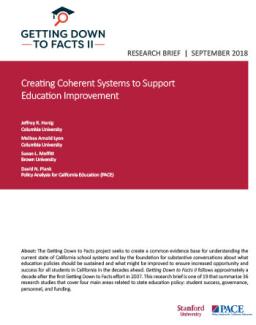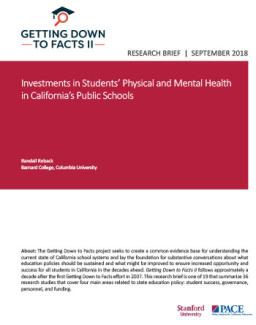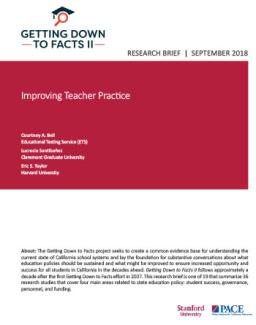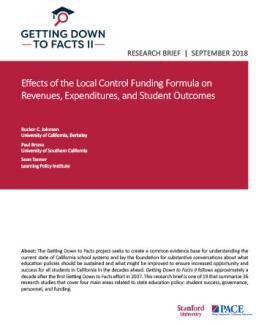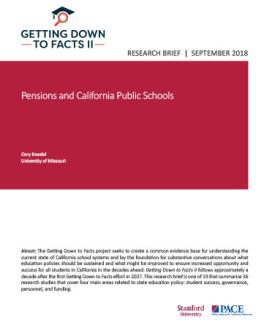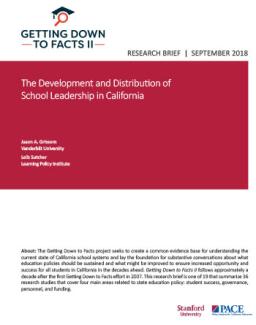Summary
In "Absent from School," PACE Executive Director Heather J. Hough analyzes student absenteeism using data from California's CORE districts. She explores the differences in absenteeism rates among students and schools, comparing them to other performance indicators. Dr. Hough also examines how schools' performance on chronic absence metrics corresponds to other accountability measures, highlighting the implications for reporting school-level measures of chronic absenteeism.
Summary
Summary
Summary
Summary
Summary
This report is the companion account of principal survey results from the Local Control Funding Formula Research Collaborative's (LCFFRC) fall 2018 surveys of stratified random samples of California superintendents and principals. The superintendent results were published in June 2018 in Superintendents Speak: Implementing the Local Control Funding Formula.
Summary
Summary
Summary
Summary
Summary
Summary
Summary
California's education system aims to provide all public school students with a broad course of study consistent with state standards. However, many educators feel that the state's funding system does not provide adequate resources to meet these expectations. While funding levels have improved, they remain below those of many other states. An adequacy study estimated that providing an adequate education would have required California to spend $25.6B more in 2016-17. The study also found that larger gaps between actual spending and adequate costs were associated with lower student performance.
Summary
Effective data use is crucial for continuous improvement, but there is confusion about how it differs from data use for other purposes. This report explains what data are most useful for continuous improvement and presents a case study of how the CORE data collaborative uses a multiple-measures approach to support decision-making.
Summary
Getting Down to Facts II reveals California's limited progress in reducing achievement and opportunity gaps for Black, Latino, low-income, and/or English language learners. The state's education reforms have relied on good intentions rather than specific accountability and enforcement, resulting in below national average outcomes. This paper examines equity in teaching, learning, finance, and accountability and concludes with a broader conception of equity for the future, whole child equity, to tackle this nearly intractable problem.
Summary
California's Local Control Funding Formula highlights low performance of special education students. Many districts allocate more base funding for all students into special education. A study found state funding growth has not kept pace with district costs, and the current formula inadequately funds preschool programs for infants and toddlers with disabilities. The study suggests better alignment between special education and the LCFF, and improved governance and accountability structures.
Summary
Charter schools serve 620,000 students in California, but their impact on traditional public schools is unknown. Charter schools have significantly better academic growth in urban areas and lower-performing groups. California's charter school authorization is decentralized with limited accountability and oversight capacity. Renewal processes are unclear, and the standards for renewal are low.
Summary
California's teacher shortage is severe, affecting high-needs students and certain subjects such as math, science, special education, and bilingual education. Factors driving the shortage include new demands for teachers, declining enrollment in teacher preparation programs, and teacher attrition. Schools are hiring teachers lacking standard credentials and formal training. Unequal teacher distribution's impact is hard to assess due to data limitations. The shortage threatens California's education initiatives.
Summary
California's education leaders and policymakers have limited ability to make informed decisions due to weaknesses in the state's education data systems. Although California has improved its data systems, it still falls behind other states in data availability and usefulness. The California Longitudinal Pupil Assessment and Data System (CALPADS) is not integrated with other data systems, and access issues further limit utilization. With additional investment, California could develop a comprehensive statewide data system to better understand what is and isn't working in its education system.
Summary
California's implementation of Common Core State Standards and Local Control Funding Formula requires new support systems for districts, including professional networks and the California Department of Education. Successful implementation requires multiagency cooperation and strategic management of relations with Washington.
Summary
Children's health, especially in low-income households, affects their future success. California has improved access to healthcare but still has gaps due to poor quality care and lack of access to providers. Mental health is a growing concern, but the state has fewer services in schools than other states. The report explores the benefits of school-based health services, which are currently lacking in California, and estimates it would cost less than $100 per pupil to improve access. California is missing out on federal funds due to its low spending on Medicaid for school-based health services.
Summary
California aims to improve the quality of teaching in its classrooms by focusing on teacher preparation and evaluation. The state's teacher preparation system aligns with standards but lacks consistent implementation. Disconnected information systems constrain policy-making, and teachers need better training for English learners. Teacher evaluation and support systems could enhance teaching effectiveness.
Summary
California's Local Control Funding Formula (LCFF) has increased per-pupil revenues, especially for low-income districts, and provided more flexibility in expenditures, leading to improvements in student outcomes. The funding was distributed based on the proportion of disadvantaged students, and expenditure increases were primarily allocated to teachers, pensions, and special education. The policy was implemented during a time of increased K-12 funding after the Great Recession and existing revenue distribution patterns.
Summary
The California State Teachers’ Retirement System (CalSTRS) has amassed a $107 billion "debt" due to the accrual of pension liabilities. CalSTRS contributions are legislated to nearly double by 2021. The higher rates are required through 2046, requiring significant contributions from teachers, school districts, and the state government. Solutions involve reducing benefits, increasing contribution rates, or modifying the underlying benefit structure. California could consider reforms from other states to develop its own policy response.
Summary
California's education system faces challenges in leadership development, with defunded professional development programs leading to inexperienced and high-turnover principals, particularly in high-poverty schools. Studies show that effective principals improve student learning, but current professional development opportunities are insufficient. Many principals seek more support, with rural areas receiving less coaching and development. Promising results have been seen from stronger state standards for administrator education programs.

